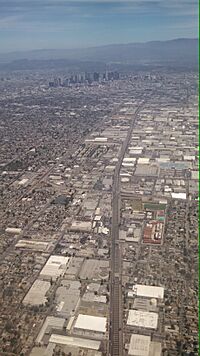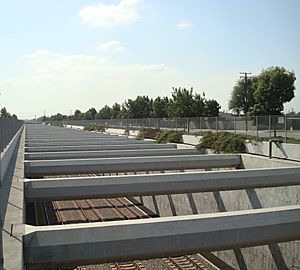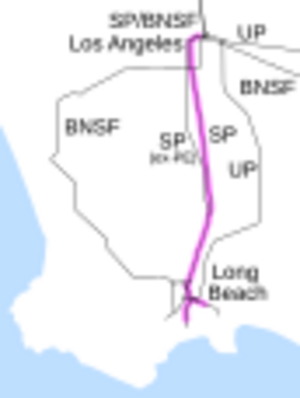Alameda Corridor facts for kids
Quick facts for kids Alameda Corridor |
|
|---|---|
 |
|

Aerial view showing Alameda Corridor trench in South Los Angeles
|
|
| Overview | |
| Owner | Alameda Corridor Transportation Authority |
| Locale | Los Angeles County |
| Service | |
| Type | freight terminal railroad |
| Operator(s) |
|
| History | |
| Opened | April 15, 2002 |
| Technical | |
| Line length | 20 mi (32 km) |
| Number of tracks | 3 |
| Character | Largely grade-separated freight railroad |
| Track gauge | 4 ft 8 1⁄2 in (1,435 mm) standard gauge |
| Operating speed | 40 mph (64 km/h) |
The Alameda Corridor is like a special "expressway" for freight trains in Los Angeles County, California. It's 20 miles long and helps connect the busy ports of Los Angeles and Long Beach to the main train lines that cross the country. These main lines belong to the BNSF Railway and Union Pacific Railroad and end near downtown Los Angeles, California.
Most of the corridor runs in a deep trench below Alameda Street. When it was built in the 1990s and early 2000s, it was one of the biggest transportation projects in the region. It helps move goods faster and safer.
Contents
How the Alameda Corridor Started

The first train tracks along Alameda Street were built way back in 1869 by the Los Angeles & San Pedro Railroad. This railroad was later bought by the Southern Pacific Railroad in 1873.
By 1984, the ports of Long Beach and Los Angeles were growing very fast. More and more cargo was coming in, and the existing train lines couldn't handle it well. One route was 90 miles long and went far out of the way. The other route, along Alameda Street, had over 200 places where train tracks crossed busy streets. Cars had to wait a long time for trains to pass, and the crossing signals were very old.
To fix these problems, the Alameda Corridor Transportation Authority (ACTA) was created in 1989. Their job was to plan big improvements for the train route.
Building the "Mid-Corridor Trench"
In 1994, the Southern Pacific Railroad sold its Alameda Street tracks to the Ports of Long Beach for $235 million. This allowed ACTA to start building the new freight rail "expressway."
The most important part of the new Alameda Corridor is the "Mid-Corridor Trench." This is a 10-mile-long, 33-foot-deep, and 50-foot-wide trench built below ground. It has three train tracks inside.
This trench and the wider corridor allow freight trains to travel at 40 miles per hour. They don't have to worry about crashing with cars at street crossings. Also, trains don't need to blow their horns as they pass through neighborhoods, which makes things quieter for people living nearby. Both the BNSF Railway and Union Pacific Railroad use these tracks.
The Alameda Corridor officially opened on April 15, 2002. In 2006, it handled up to 60 trains each day. While the number of trains has gone down since then, the trains themselves have become much longer. In 2021, fewer trains carried the same amount of cargo as in 2006. The entire project cost about $2.1 billion to build.
By 2013, the corridor was carrying about one-third of all the freight going to and from the Ports of Los Angeles and Long Beach. It handles 15% of all container traffic in the entire United States!
Besides the main trench, ACTA also takes care of over 65 miles of other train tracks. This includes 125 places where tracks split, ten train bridges, signals at 48 spots, seven street-level crossings, and two pump stations for stormwater.
In 2024, a new company called the Alameda Belt Line started managing the train movements. It's owned by both BNSF and Union Pacific, acting as a neutral helper.
Other Important Projects
Alameda Corridor–East Project
The Alameda Corridor–East project started in 1998. Its goal is to improve over 70 miles of train tracks east of Downtown Los Angeles. This project is building 19 "grade separations." A grade separation means building a bridge or tunnel so that train tracks and roads don't cross at the same level. This helps get rid of 23 street-level crossings.
These crossings used to cause long traffic jams on north-south streets as long freight trains passed. Now, with the grade separations, traffic flows much better. Many of these improvements have already been finished, and more are being built or planned.
One big part of this project was the $336.9 million San Gabriel Trench. This project put the train tracks underground in San Gabriel. Construction started in 2012 and was completed in 2017.
Could the Corridor Use Electric Trains?
The Alameda Corridor was built in a way that would allow it to use electric trains in the future. This would mean adding electric wires above the tracks, called "catenary wires." Using electric trains instead of diesel ones would be much better for the environment. It would reduce air pollution in the area.
Even though electric freight trains are common in many other parts of the world, this idea hasn't happened yet in North America. The region around the corridor has a lot of air pollution from trucks on Interstate 710. Switching to electric trains could help make the air cleaner.
See also
- Urban freight distribution
- Redondo Junction, California


